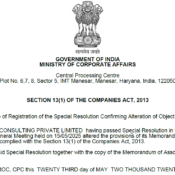How to File Regular GST Return
Generally, there are several steps to follow when it comes to filing the regular GST return in India. The steps are grouped into three categories. They are: the filing procedure, the forms to be filed, and the design of the return.
Table of Contents
ToggleForms to be filed
Depending on the annual turnover of your business, you may need to file a regular GST return. There are 22 different types of returns. Each return reflects the tax paid by the taxpayer and the amount of tax collected from the suppliers. All returns are required to be filed on the Indian government’s GST portal. The portal allows businesses to upload invoices whenever they have an internet connection.
You will need to fill out the details of all your taxable supplies in three different sections. You will also need to fill out the details of any changes you have made to taxable supplies. You will also have to enter information related to TDS deductions and tax credit paid.
You will need to fill out details of all your outward supplies and inward supplies. You will also have to enter information about taxable inward supplies. You will also have to fill out details of any tax credit received or refunds claimed.
GST return due dates
Various types of GST returns are required to be filed by the tax payers. These returns help the tax authorities to calculate the tax liability. These returns include GSTR-1, GSTR-3B, GSTR-7, GSTR-8, GSTR-9 and GSTR-10. The due dates of these returns vary according to the type of registration.
GSTR-1 is a monthly return that showcases the sales transactions of a business. It includes details of taxes collected and TDS liability paid. It is due on the 18th of the following month. It also includes details of outward supplies made in the previous month. It is due on the 10th of the following month.
GSTR-7 is required to be filed by e-commerce operators. It records details of supplies made through the e-commerce platform. It also details the TCS collected. It is due on the 10th of each month. The penalty for not filing this return is Rs 100 per day for SGST.
GSTR-3B is required to be filed by all taxpayers who are registered under the GST. It is due on the 20th of the following month. The businesses can file it in stages, between the 20th and 24th day of the following month. It is digitally signed and must be submitted with the payment of the taxes.
GST return Form
Depending on your state’s tax rules, you might be required to file a regular GST return. Depending on your annual aggregate turnover, you may need to file a monthly or quarterly return.
A regular return is a form that requires you to fill in details about the outward supplies you have made in a given month. The form has 13 sections that are separated into sub-sections.
The first section of the form asks you to enter your name and legal identity. Next, you must fill in the details of all invoices that have been raised against your sales for the month. In addition, you need to enter the amount of the tax you have collected for the month. This includes interest on the tax that is due. The maximum amount of interest that you can pay is 18%. You should also ensure that you enter your GSTIN, which is a fifteen-digit number assigned by the tax authorities.
The second section of the form asks you to enter details of all inward supplies you have made. These supplies include invoices issued to you for the purchase of goods. In addition, you must also enter details of credit notes or debit notes issued to you for your inward supplies.
GST return filing procedure
Depending on the tax period, taxpayers must file a number of GST returns. The due dates and forms vary. These forms contain details of the supplies and tax collected from each supplier. It is important to choose the correct form and file it in time.
The return filing procedure can be completed online or offline. There are 11 different types of returns that are used under the GST regime. The returns contain information about the tax collected, the income of the taxpayer, and all supplies. These are listed below.
The tax payer should fill in the basic details in parts 4 to 5. He/she must also fill in the details of taxable outward and inward supplies. In addition, he/she must also provide details related to TDS interest and refund claims from an electronic cash ledger.
The form is due on the tenth day of each month. However, it is important to file it within ten days of the end of the tax period. A late fee of INR 200 per day will be levied if the return is not filed by the due date. The maximum late fee is INR 5,000.
How to file GST return by yourself?
You can file your GST return yourself by following these steps:
Gather all the necessary documents (sales invoice, purchases etc.) and information, including your GST registration number, invoices for sales and purchases, and any applicable credits or exemptions.
- Access the GST portal and log in using your login credentials.
- Navigate to the “Returns” section and select the appropriate return filing period.
- Select the type of return you need to file (e.g., GSTR-3B, GSTR-1, GSTR-4, etc.).
- Enter the required information and upload any supporting documents.
- Review your return for accuracy and completeness.
- Submit your return and pay any applicable taxes.
It is a good idea to consult with a tax professional like Us or refer to the GST portal for more detailed instructions, as the specific steps and requirements for filing a GST return may vary depending on your location and the type of return you are filing.
GST Consultant
Our office is a top GST consultant can help a business to file regular GST returns by providing expert guidance on GST compliance and ensuring that the business is meeting all of its GST obligations. Our GST office can also help to identify any potential GST savings or refunds that may be available to the business.
Important Links –
Like Us On Facebook

Our Client's Review
EXCELLENTTrustindex verifies that the original source of the review is Google. Best place to file ur GST n IT returns .. They respond quickly, communicate well and get ur work done as per ur needs in a very short time ..Posted onTrustindex verifies that the original source of the review is Google. Best place for Income tax filingPosted onTrustindex verifies that the original source of the review is Google. Of all the CA, CS teams I have interacted with, they are the most prompt and organized. I have taken their services for almost 3 years now for various things like income tax queries, income tax filing, networth certificates, and compliance certificates. They always display a clear understanding of the law and are also able to explain it to you in layman terms. Overall a very resourceful and courteous team. Thank you for the support!Posted onTrustindex verifies that the original source of the review is Google. Best company secretary I bangalore ever seen such quick quality servicePosted onTrustindex verifies that the original source of the review is Google. Prakasha & Co has been a lifesaver for me when it comes to my tax dispute and filings with IT office. They are always very responsive and helpful whenever I have any questions or issues, I recently had an issue with my sister business GST filings, and they were able to quickly identify the issue and help me resolve it. They really go above and beyond to make sure their clients are taken care of.Posted onTrustindex verifies that the original source of the review is Google. ''The team at Prakasha& Co made sure my company was compliant with all the legal requirements. Their attention to detail and timely response was truly remarkable."Posted onTrustindex verifies that the original source of the review is Google. "I was impressed with the level of customer service provided by Prakasha& Co. They were always available to answer my questions and provide guidance throughout the company registration process."
Important Links
- Top 10 GST Registration Consultants in Bangalore
- Top 10 Best Income Tax Lawyers in Bangalore
- Top 10 Trademark Registration Consultants in Bangalore
- GST Registration in Bangalore
- Private Limited Company Registration in Bangalore
- Partnership Firm Registration in Bangalore
- Proprietorship Registration in Bangalore
- Trademark Registration in Bangalore
- Audit Frim in Bangalore
- CA Firm in Bangalore
- Accounting Services in Bangalore
- GST Lawyers in Bangalore
- Payroll Services Provider in Bangalore
- Payroll Consultant in Bangalore
- Income Tax Lawyer in Bangalore
All Categories
- Audit
- Blogs
- Bookkeeping Services
- Company Registration
- Company secretary Legal & Chartered Accountant
- Digital Signature Certificate (DSC) Services
- FSSAI Registration and Consultation
- GST
- Income tax
- Partnership Firm Registration
- Payroll Services
- Risk Management Services
- Startup Registration Process
- Trademark Registration
- Uncategorized








